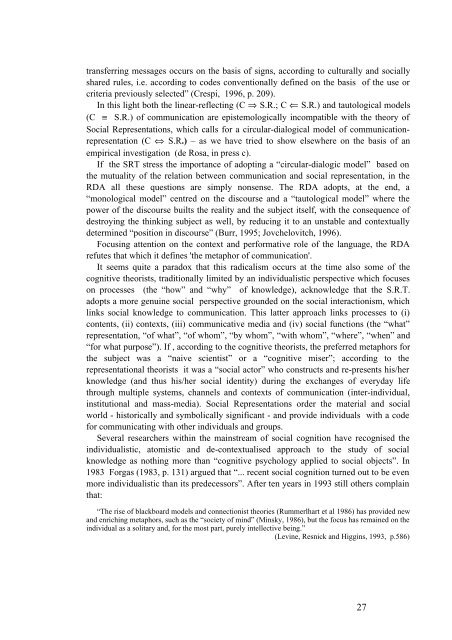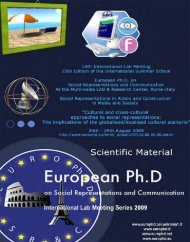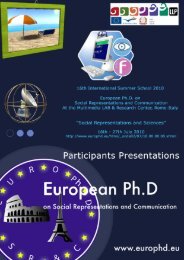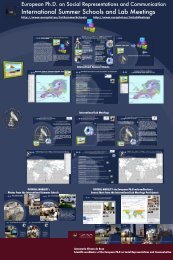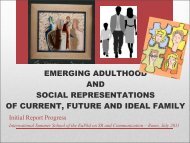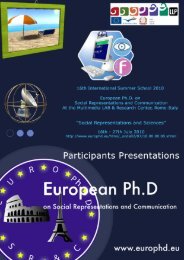The "boomerang" effect of the radicalism in discourse analysis
The "boomerang" effect of the radicalism in discourse analysis
The "boomerang" effect of the radicalism in discourse analysis
You also want an ePaper? Increase the reach of your titles
YUMPU automatically turns print PDFs into web optimized ePapers that Google loves.
transferr<strong>in</strong>g messages occurs on <strong>the</strong> basis <strong>of</strong> signs, accord<strong>in</strong>g to culturally and socially<br />
shared rules, i.e. accord<strong>in</strong>g to codes conventionally def<strong>in</strong>ed on <strong>the</strong> basis <strong>of</strong> <strong>the</strong> use or<br />
criteria previously selected” (Crespi, 1996, p. 209).<br />
In this light both <strong>the</strong> l<strong>in</strong>ear-reflect<strong>in</strong>g (C ⇒ S.R.; C ⇐ S.R.) and tautological models<br />
(C ≡ S.R.) <strong>of</strong> communication are epistemologically <strong>in</strong>compatible with <strong>the</strong> <strong>the</strong>ory <strong>of</strong><br />
Social Representations, which calls for a circular-dialogical model <strong>of</strong> communicationrepresentation<br />
(C ⇔ S.R.) – as we have tried to show elsewhere on <strong>the</strong> basis <strong>of</strong> an<br />
empirical <strong>in</strong>vestigation (de Rosa, <strong>in</strong> press c).<br />
If <strong>the</strong> SRT stress <strong>the</strong> importance <strong>of</strong> adopt<strong>in</strong>g a “circular-dialogic model” based on<br />
<strong>the</strong> mutuality <strong>of</strong> <strong>the</strong> relation between communication and social representation, <strong>in</strong> <strong>the</strong><br />
RDA all <strong>the</strong>se questions are simply nonsense. <strong>The</strong> RDA adopts, at <strong>the</strong> end, a<br />
“monological model” centred on <strong>the</strong> <strong>discourse</strong> and a “tautological model” where <strong>the</strong><br />
power <strong>of</strong> <strong>the</strong> <strong>discourse</strong> builts <strong>the</strong> reality and <strong>the</strong> subject itself, with <strong>the</strong> consequence <strong>of</strong><br />
destroy<strong>in</strong>g <strong>the</strong> th<strong>in</strong>k<strong>in</strong>g subject as well, by reduc<strong>in</strong>g it to an unstable and contextually<br />
determ<strong>in</strong>ed “position <strong>in</strong> <strong>discourse</strong>” (Burr, 1995; Jovchelovitch, 1996).<br />
Focus<strong>in</strong>g attention on <strong>the</strong> context and performative role <strong>of</strong> <strong>the</strong> language, <strong>the</strong> RDA<br />
refutes that which it def<strong>in</strong>es '<strong>the</strong> metaphor <strong>of</strong> communication'.<br />
It seems quite a paradox that this <strong>radicalism</strong> occurs at <strong>the</strong> time also some <strong>of</strong> <strong>the</strong><br />
cognitive <strong>the</strong>orists, traditionally limited by an <strong>in</strong>dividualistic perspective which focuses<br />
on processes (<strong>the</strong> “how” and “why” <strong>of</strong> knowledge), acknowledge that <strong>the</strong> S.R.T.<br />
adopts a more genu<strong>in</strong>e social perspective grounded on <strong>the</strong> social <strong>in</strong>teractionism, which<br />
l<strong>in</strong>ks social knowledge to communication. This latter approach l<strong>in</strong>ks processes to (i)<br />
contents, (ii) contexts, (iii) communicative media and (iv) social functions (<strong>the</strong> “what”<br />
representation, “<strong>of</strong> what”, “<strong>of</strong> whom”, “by whom”, “with whom”, “where”, “when” and<br />
“for what purpose”). If , accord<strong>in</strong>g to <strong>the</strong> cognitive <strong>the</strong>orists, <strong>the</strong> preferred metaphors for<br />
<strong>the</strong> subject was a “naive scientist” or a “cognitive miser”; accord<strong>in</strong>g to <strong>the</strong><br />
representational <strong>the</strong>orists it was a “social actor” who constructs and re-presents his/her<br />
knowledge (and thus his/her social identity) dur<strong>in</strong>g <strong>the</strong> exchanges <strong>of</strong> everyday life<br />
through multiple systems, channels and contexts <strong>of</strong> communication (<strong>in</strong>ter-<strong>in</strong>dividual,<br />
<strong>in</strong>stitutional and mass-media). Social Representations order <strong>the</strong> material and social<br />
world - historically and symbolically significant - and provide <strong>in</strong>dividuals with a code<br />
for communicat<strong>in</strong>g with o<strong>the</strong>r <strong>in</strong>dividuals and groups.<br />
Several researchers with<strong>in</strong> <strong>the</strong> ma<strong>in</strong>stream <strong>of</strong> social cognition have recognised <strong>the</strong><br />
<strong>in</strong>dividualistic, atomistic and de-contextualised approach to <strong>the</strong> study <strong>of</strong> social<br />
knowledge as noth<strong>in</strong>g more than “cognitive psychology applied to social objects”. In<br />
1983 Forgas (1983, p. 131) argued that “... recent social cognition turned out to be even<br />
more <strong>in</strong>dividualistic than its predecessors”. After ten years <strong>in</strong> 1993 still o<strong>the</strong>rs compla<strong>in</strong><br />
that:<br />
“<strong>The</strong> rise <strong>of</strong> blackboard models and connectionist <strong>the</strong>ories (Rummerlhart et al 1986) has provided new<br />
and enrich<strong>in</strong>g metaphors, such as <strong>the</strong> “society <strong>of</strong> m<strong>in</strong>d” (M<strong>in</strong>sky, 1986), but <strong>the</strong> focus has rema<strong>in</strong>ed on <strong>the</strong><br />
<strong>in</strong>dividual as a solitary and, for <strong>the</strong> most part, purely <strong>in</strong>tellective be<strong>in</strong>g.”<br />
(Lev<strong>in</strong>e, Resnick and Higg<strong>in</strong>s, 1993, p.586)<br />
27


